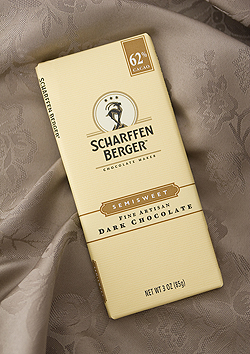

The Scharffen Berger logo features an ibex mountain goat and three stars. All photography by Saidi Granados.
|
PETER ROT is the THE NIBBLE’s chocolate specialist.
|
September 2008
|
 |
Scharffen Berger Chocolate
Page 3: Blended Chocolate Bars
This is Page 3 of a six-page article. Click on the black links below to visit other pages.
Blended Chocolate Bars
To blend or not to blend? You may have heard or read somewhere that origin chocolate, where the beans come from one geographical location, is “better” than blended chocolate, in which the beans come from as many as 24 different geographical locations (origins). Or you may have heard the opposite argument.
First, remember the broad interpretation of “origin” or “single origin” chocolate. Only that which comes from one single plantation is truly “single origin” like a French vineyard. All other origin chocolate is a blend of beans from a larger geographical area—an entire country, which can be a small Caribbean island, or five Caribbean countries. However, even these broad geographies do produce similar taste characteristics. This is why some people develop preferences for specific origins, just as they may prefer Burgundy over Bordeaux, while others like both origins equally.
Thus, the decision as to which presentation of the cacao is “better” is based on personal preference, and there is no absolute truth. Otherwise stated, is pure chocolate or coffee ice cream better than mocha or jamocha almond fudge?
There are several advantages, in both mass-produced and artisan chocolate, to blending beans from different locales. Chocolate makers blend beans:
- To hide undesirable flavors in inexpensive brands. Blending beans from different origins allows industrial-sized companies to use lower grade, less expensive beans, some of which are potentially moldy, poorly fermented, burnt during roasting or even raw. The flavors of such beans, when blended within a vast sea of other beans, tend to get masked, so their effects are hidden or at best minimal. Most of the mass-marketed, candy store variety of chocolate is made with inexpensive beans. This type of chocolate also has more sugar, and sometimes other flavors, added to the final product, such that the taste of the cacao is not a priority.
- To create a consistent flavor from batch to batch. Blending different types of cacao beans is a strategy that both industrial-sized and artisan companies employ to achieve a reliable and consistent flavor for each batch of chocolate. Beans sourced from a single origin can have different flavors each year, so blending allows for greater control in the flavor process.
- To create a distinct or desired flavor. Blending is important if a maker wishes to create a flavor profile that’s either too difficult or impossible to find in any origin. This is often done to achieve an optimal balance of flavor properties such as acidity, fruitiness, nuttiness or other qualities that can be too strong in cacao sourced from one origin. Top-ranked makers such as Amedei and Valrhona use blending extensively for this reason, and the results have been nothing short of outstanding.
|

Most of Scharffen Berger’s bars are blended bars. You see the percentage of cacao (here 62%), but no information as to where the beans are from. |
So if you’re craving a fruity chocolate, you would probably have more luck by selecting an origin chocolate renowned for its fruitiness than a blended bar designed to deliver a balanced flavor. Alternately, if you’re making a hazelnut praline and don’t want the chocolate’s flavor qualities (for example, fruitiness) to interfere with the nuttiness, you might opt for a blended, neutral chocolate, or an origin that has a nutty flavor.
Continue To Page 4: Scharffen Berger History
Go To Article Index Above
Lifestyle Direct, Inc. All rights reserved. Images are the copyright of their respective owners.

|





